The Creation of Queensland Raceway
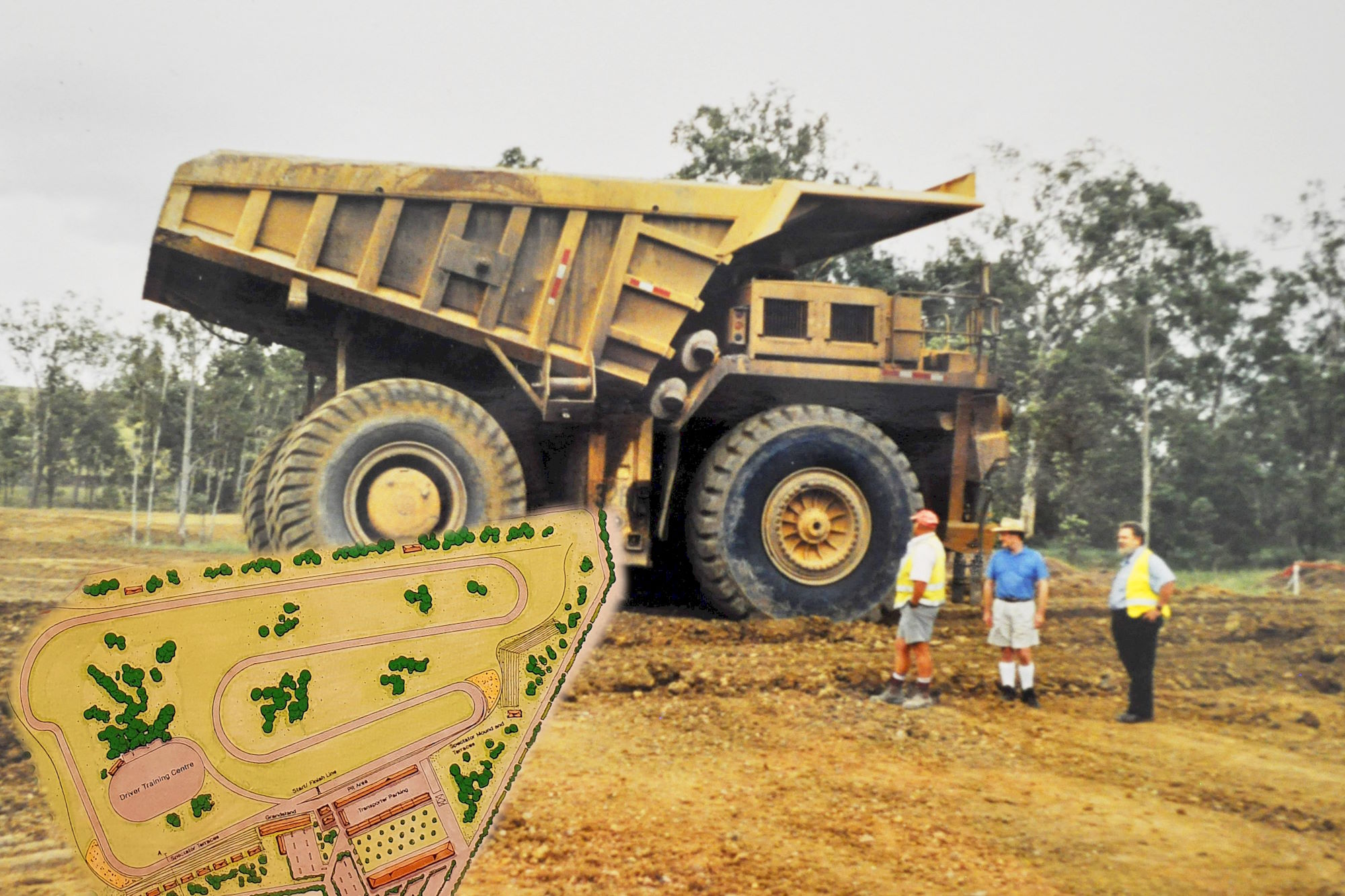
Over the past 25 years, Queensland Raceway has amassed an incredible array of stories.
From boggy beginnings, political battles with CAMS and ultimately the government, to reinvention through the hands of multiple owners, the six-turn circuit referred to as the Paperclip has a treasure trove of lesser-told yarns.
In this sequence of features, we will delve into the circuit’s design constraints and many of the hidden elements you would never consider when looking at race circuits.
To kick things off, we travel back to the mid-1990s, to a motorsport-mad state with precious few places to race…
The Story of Queensland Raceway Quick Links
Preamble 1: Ipswich’s Remarkable Motorsport Heritage
Preamble 2: Building a Motorsport Precinct: Willowbank Raceway
Preamble 3: The Evolution of a Motorsport Precinct
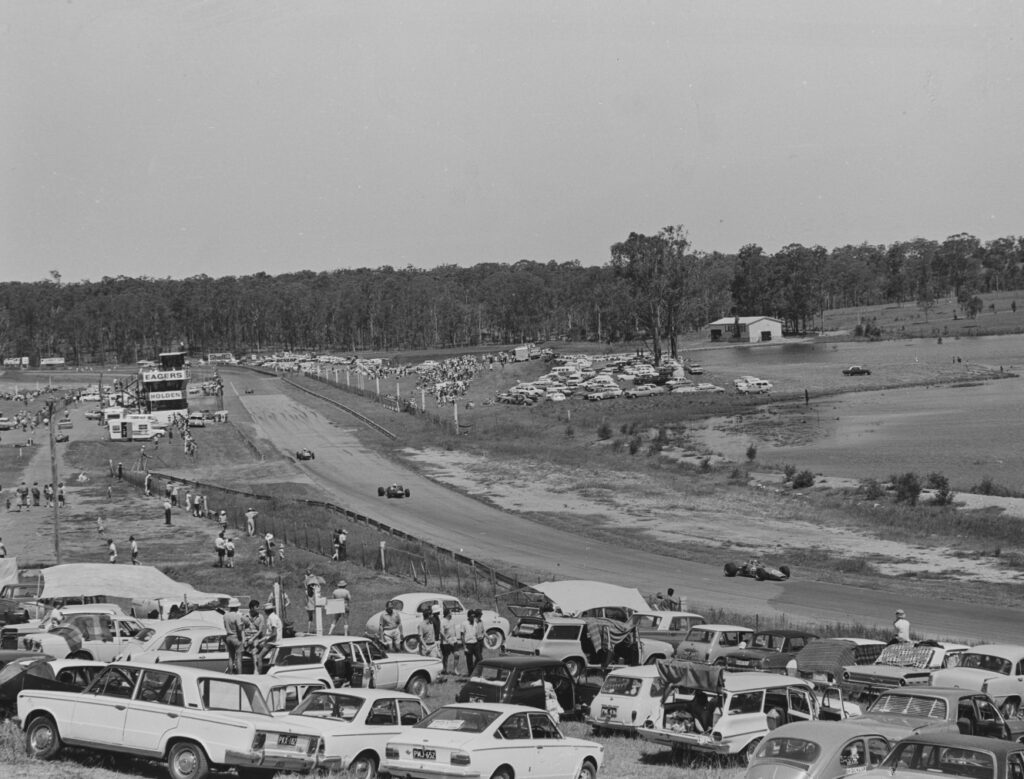
The early days of Lakeside Raceway – State Library of Queensland
In Search of Circuits
In the 1990s, the Queensland motorsport scene was in a tight spot – it was in dire need of a new racing venue, as there were limited options available outside of Lakeside Raceway.
There was a smattering of dirt short circuits across the Darling Downs – the original dirt Morgan Park Raceway 730m long track wasn’t sealed until 1997, the Gold Coast Indy circuit was a once-a-year proposition, Surfers Paradise International was swallowed up by developers and shut in 1987, while Lowood (1966) and Strathpine (1959) were distant memories.
From the mid-1980s, there was continued hope of a circuit at Darlington Park, halfway between Brisbane and the Gold Coast – it was an ongoing saga that we covered on these pages previously – but sadly, that project never saw the light of day.
Monopolies are bad for business, and the competitors of the day pushed any available wheelbarrow to find a solution.
Then, in July 1996, the press sprung to life, with three separate new facilities in the works: one at the Dreamworld theme park, which hoped to lure the Indycar Series away from its Surfers Paradise home, PROCAR chief Ross Palmer was looking at multiple sites in the Gold Coast Hinterland to build a motorsport country club, while a third venue was being planned to the north of Brisbane.
Not included on the list, out at Willowbank, the Ipswich City Council invited tenders to build a circuit within its established motorsport precinct.

An aerial view of the Ipswich Motorsport Precinct in 1997, with Queensland Raceway’s block on the left, waiting for development… Image: Qimagery
The Missing Link
Come the early 1990s, the missing link from the Ipswich Motorsport Precinct was a circuit racing facility – and as fortune would have it, there was a spare block at the end of Champions Way.
While vacant land sitting and waiting with council blessing for a new race circuit to be built is akin to unicorn droppings, the block had its issues—it was small, and it had a creek running right through it.
The council initially contacted Dick Johnson Racing manager Wayne Cattach for advice on the matter, with the Ipswich City Council’s ultimate tender process attracting two bidders by the end of 1996.
According to Auto Action, on December 19, 1996, Brisbane solicitor Gregor McCarthy, a partner in the law firm McCarthy, Palethorpe, and Blanch, lodged one submission.
As it transpires, Mr McCarthy was also listed as a director of Lakeside Raceway, however, Lakeside promoter David Harding noted that the tender was “news to him,” going on to say that his venue was under no threat from a new circuit at Ipswich.
“Lakeside has served motor racing in South East Queensland and Australia for 35 odd years and there is no suggestion it won’t continue to do so. Lakeside is a good motor racing circuit and meets all the safety standards in accordance with its CAMS track license,” Harding said.
When Motorsport News contacted Mr McCarthy, he noted that he represented a consortium that would reveal themselves in due course.
Ipswich City Council’s Business Development Manager Laurie Mundt also stated in the same piece- “We have asked both tenderers for additional information – like you, we don’t know who one of the tenderers is – and once we have that information, we can proceed with the final assessment.”
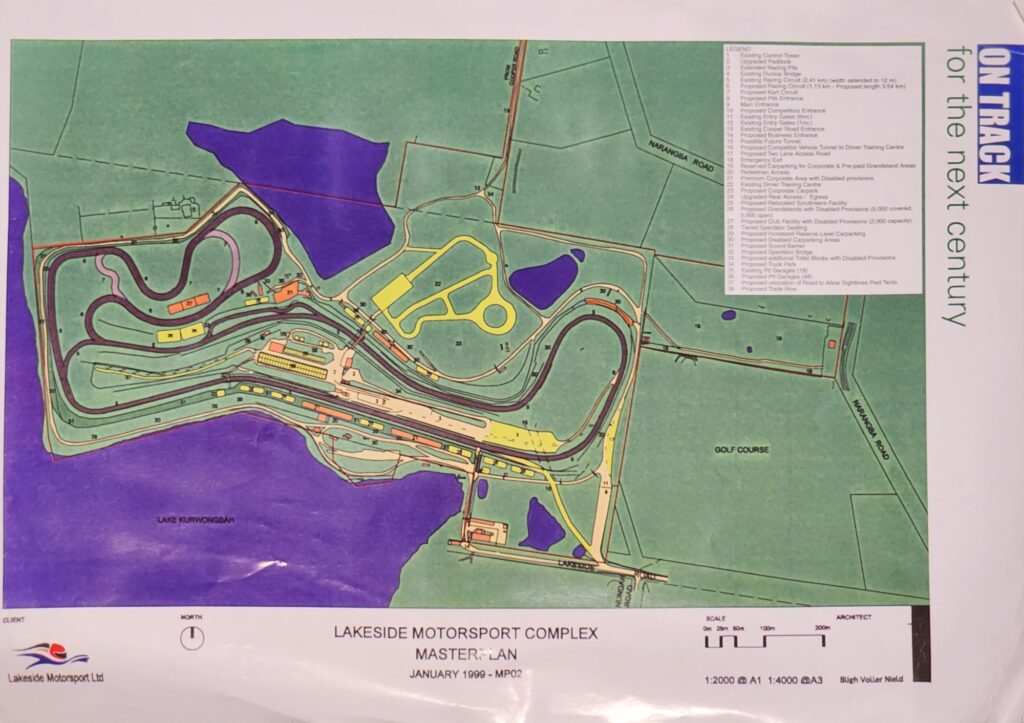
At the time of Queensland Raceway’s development, Lakeside Raceway floated its own renovation plans and membership drive.

Dennis Brown at the Leyburn Sprints.
The other bid was from the startup not-for-profit club called Motorsport Queensland Limited.
The group was founded by Dennis Brown, who had significant credits and connections from throughout the motorsport world.
A long-time rally competitor, his resume included being a state champion and a member of the Holden Precision Driving Team.
Brown started working with Dick Johnson in 1974 before ultimately becoming DJR team manager in 1986, then spending a stint with Colin Bond’s outfit.
He was well connected with the various levels of government and had the backing of Johnson and Cattach.
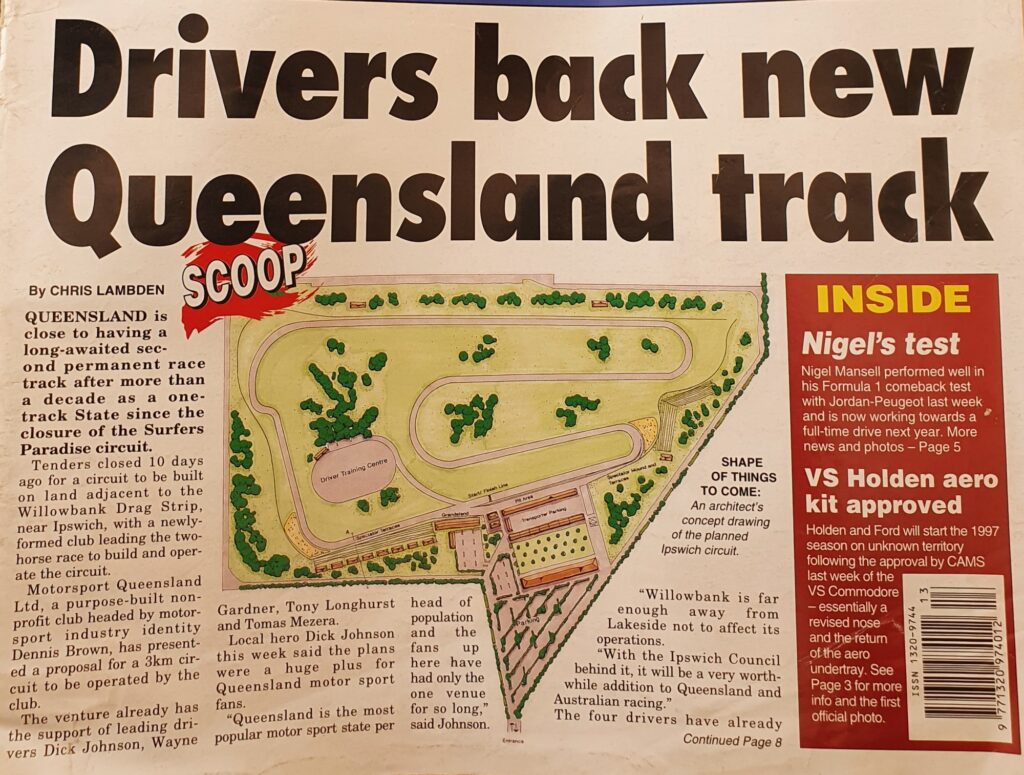
Motorsport News, Issue 90, 20th December 1996
By the end of 1996, renders of the club’s prospective 3km circuit graced the front page of Motorsport News, with the bid carrying support from Johnson, Wayne Gardner, Tony Longhurst and Tomas Mezera.
Originally running under the working title of Ipswich Raceway or Ipswich International Raceway, the venue would become known as Queensland Raceway.
Funding for the venture would come from various sources. A total of 1,000 life memberships were offered for $1,000 a pop, plus 500 family memberships for $1,500 each, which was enough to get the ball rolling.
The privileges of life memberships included free entry to all motorsport events at the circuit, a discount on track hire, discounts on competitor entry at Motorsport Queensland events, exclusive general practice sessions for life members with separate sessions for cars and bikes, a specially struck badge, hospitality facilities at major events, and dedicated parking areas.
The memberships were transferable, making them a valuable commodity.
Following the initial construction of the FIA-spec circuit, the next step was to construct upgraded spectator amenities, plus pit and corporate box facilities.
Importantly, the venture had the backing of CAMS, TEGA and TOCA.
“The concept of a non-profit club-based structure, rather than a private promoter, has a lot of plusses. It certainly falls within the preferred policy of the government and Ipswich Council, and must help our case for their support. We want to produce a challenging course, with a number of good passing spots, so the existing drawing is pretty much a base concept.”
Dennis Brown to Motorsport News, December 20, 1996
An added bonus of the club structure was that profits would be poured back into the facility, another factor that endeared it with the various levels of government.
By the start of April 1997, the Ipswich City Council confirmed Motorsport Queensland as the winning bidder with a 30-year lease plus a 30-year option, with Queensland Sports and Recreation Minister Mick Veivers offering his “full support.”
Things swiftly kicked into gear, the life memberships were sold around the world to Britain and South Africa, with founding members including V8 Supercar drivers Dick and Steven Johnson, Longhurst, Mark Larkham, Wayne Gardner and Alan Jones.
General memberships also took off, too, with it quickly becoming the largest CAMS-affiliated club in the state, with non-voting membership available for $50, and voting membership for $100.
Otherwise, the project was to rely on $1 million in borrowings from the Bank of Queensland, the sale of cleared timber from the development of the site, and, importantly, the Queensland State Government.
Initially, the Coalition government under Premier Rob Borbidge granted Motorsport Queensland $1.5 million to get the ball rolling, after eventually approving construction and the business plans in September 1997.
The Queensland Raceway website noted at the time of its launch that many private companies and individuals assisted, while the “Ipswich City Council have done everything possible to assist us, and everyone from the Mayor down is an enthusiastic supporter.”
It is believed that a portion of spectator gate takings would go to the Council as part of the facility’s ongoing lease conditions.
The new Peter Beattie Labor government also joined the party when it was voted in, with the circuit coming under the watch of Sports Minister Bob Gibbs.
While Motorsport Queensland signed on to build the race circuit, the startup was quick to distance itself from the Lakeside-aligned Interactive Motorsport and Recreation Queensland, which set its sights on building a paved oval on a block of private land adjacent to the new track.
The Ipswich City Council, however, noted that no plans were lodged at that time for the proposed speedway. Simultaneously, NASCAR racer Ken James floated the idea of building a short oval at Darlington Park.
While a level of earthworks was carried out on the Willowbank oval, neither that nor the Darlington Park facility ever saw the light of day.
By June 1997, Motorsport Queensland was busy drumming up support for the venture – Peter Brock, Johnson, Longhurst, and Greg Murphy had all seen plans for the venue and supported it, with the club keen to apply for a round of the 1998 Shell Australian Touring Car Championship.
It was noted that for spectators, the large viewing mounds encircling the track would allow for great sight lines of the entire venue.
“I wanted a track where anyone could see from anywhere,” Brown told the Courier Mail.
“What we’re building as much as anything is entertainment.”
The Ipswich Council proposed a ‘Speed Week’ celebration in the precinct, which would bring together V8 Supercars and the Winternationals.
While QR was in the works, the Council circulated collateral spruiking the possibilities for the precinct, which included a proposed motorsport technology park and museum, with the circuit racing facility in its earliest iterations hosting “Group A Racing, jet boats, motorcycle racing, truck racing, driver training facilities, motorkhanas, motor trade shows and expos.”
Elsewhere, Motorsport News reported that the adjacent Ebenezer Mining Company would contribute earth fill and earthmoving services for the project.
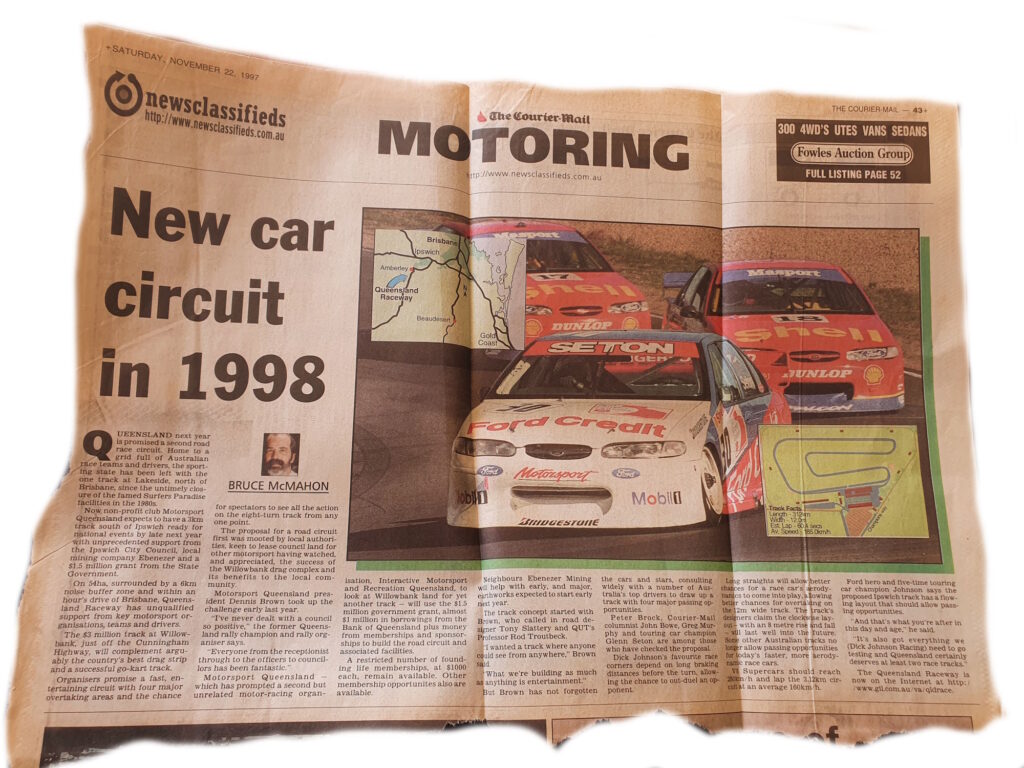
The Courier Mail reported that Motorsport Queensland had engaged road designer Tony Slattery and QUT’s Professor Rod Troutbeck, with a brief to create a track that raced well.
Coming in at 3.1km, the layout featured long straights into tight corners, which promoted overtaking, and it had to be wide, with 12m as the ultimately chosen width.
Early theories had cars reaching a top speed of 280km/h and an average of 160km/h, with the six-turn course featuring four genuine passing spots.
Talking to the Courier Mail, Dick Johnson noted that the flowing nature of the track would encourage overtaking – “And that’s what you’re after in this day and age. It’s also got everything we (Dick Johnson Racing) need to go testing, and Queensland certainly deserves at least two racetracks.”
By February 1998, Queensland Raceway had signed on with AVESCO for a three-year deal, bringing the number of long-term contracted tracks to the series to five. The move immediately clouded the future of V8 Supercars at Lakeside Raceway.
“The market can support it, if the facility (Lakeside) is one of the 10 best in the country that is available to us, then we will go there,” said AVESCO CEO Garry Craft to Auto Action.
“We currently have contracts with five circuits out of the ten. Therefore, five slots are available.
“We work very hard to get the fans to the track, if they don’t have a good experience, they will not come back, and you can’t blame them.”
Lakeside replied that it was installing new garages for the 1998 event, while Craft responded that they were a cosmetic improvement.
By July 1998, Queensland Raceway was officially in the game for a 500km V8 Supercars race.
“Are we open for offers? – yes,” said Craft to Motorsport News.
“It would be a good thing for the category and the circuit, we’ve run too long with the same old stuff in terms of events. It’s nice to see new venues and promoters having a look at new things.”
Brown noted – “We’re talking to sponsors, and the response is optimistic. The pit design was modified late in the process and will now accommodate 50 cars (up from the original 40).”
The same article noted:
Construction of the new circuit, operated by Motorsport Queensland, is due to get underway very shortly after a late hitch involving the adjacent mining company has been overcome. Concerns about possible flooding of the mine as a result of the construction works at the track site led to the mining group taking an injunction to halt work. Those fears have now been allayed, and Motorsport Queensland has agreed to take out insurance to cover the possibility. Half the site is already cleared and work on the balance will start any day, upon the lifting of the injunction.
Another issue was an access road that the mine had earlier run through the Queensland Raceway block.
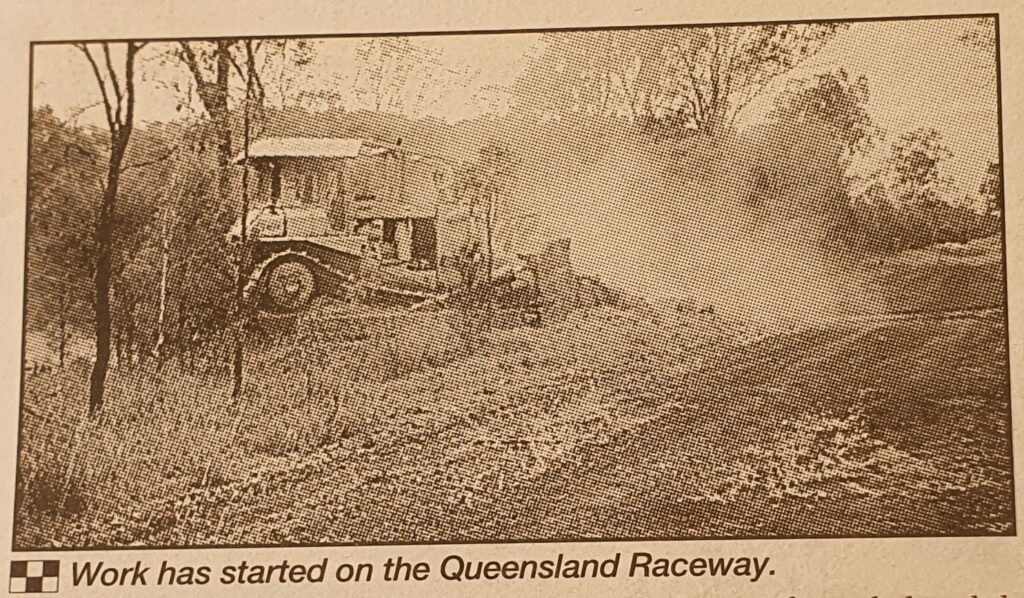
By the start of August, Auto Action featured a photo of a bulldozer swinging into action, above.
“The mining company is a major employer in the Ipswich region and needed to ensure its operations would be fully protected, especially during the time we will be moving large amounts of fil around the site,” said Brown.
With the trees cleared, Motorsport Queensland members were invited to inspect the prospective layout, with star pickets and bunting denoting the various corners.
Elsewhere, Motorsport Queensland supplemented its income by selling branded personalised number plates.
To get things rolling within the club, it organised the off-road Ipswich 300 around the coal mines at Swanbank, the opening round of the Australian Offroad Championship and the second round of the Queensland Long Course Off Road Championships.
The 42km course was completed eight times, with Terry Rose taking the victory.
The event was directed by Derrick Kennedy, with Pat Heatherman the track director.
This was merely the beginning of the tale – stay tuned for future instalments, firstly focused on the design and construction of the venue built in the bog.
Then, when the circuit was finally up and running, it faced the traffic jam of all traffic jams.
The inaugural Queensland 500 was next, an event that ultimately unravelled Motorsport Queensland following a spectacular stoush with the Queensland Government.
The venue then rose from the ashes, although ongoing battles with V8 Supercars were forever a talking point.
Strap in, it’s going to be a wild ride…








